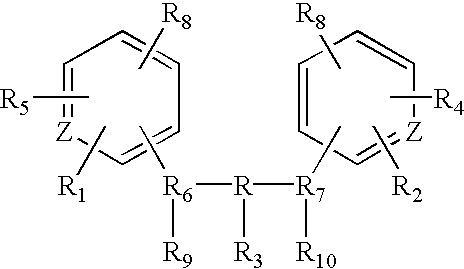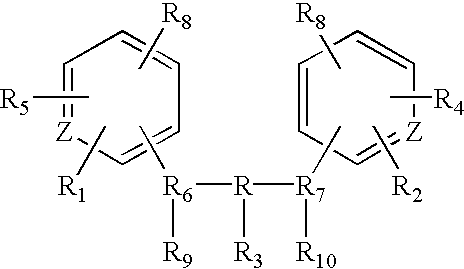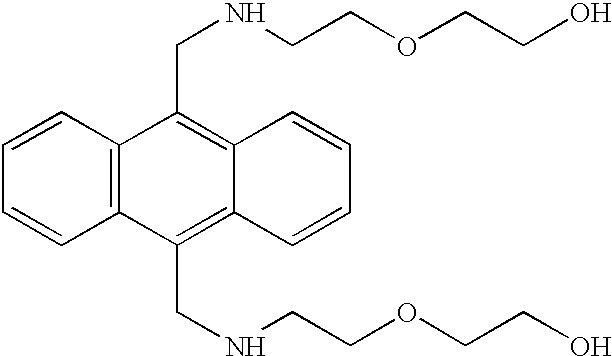Detection of glucose in solutions also containing an alpha-hydroxy acid or a beta-diketone
a technology of glucose and solution, applied in the field of detection of glucose in samples, can solve problems such as reducing the specificity of glucose assay
- Summary
- Abstract
- Description
- Claims
- Application Information
AI Technical Summary
Benefits of technology
Problems solved by technology
Method used
Image
Examples
example 1
Water Soluble Copolymer of Anthracene Derivative and MAPTAC
[0073] I. Synthesis of Mono-Boronate-Anthracene Indicator Co-Polymerized in Water-Soluble Polymer:
[0074] A. 9-[3-(methacrylamido)propylamino]methylanthracene
[0075] To a suspension of N-(3-aminopropyl)methacrylamide hydrochloride salt (11.82 g, 66.0 mmole, 3.0 equiv.) and DBMP (10 mg as inhibitor) in 250 mL CHCl.sub.3 at 0.degree. C. was added dropwise DIEA (18.5 g, 25.0 mL, 144 mmole, 6.5 equiv.) over a 20 min period. The mixture was allowed to warm to 25.degree. C. and then recooled to 0.degree. C. To the cooled mixture was added dropwise a solution of 9-chloromethylanthracene (5.0 g, 22 mmole) in CHCl.sub.3 (100 mL) over a 1 hour period. The mixture was subsequently stirred at 25.degree. C. for 1 hour, 50.degree. C. for 12 hours and then 70.degree. C. for 2 hours. At this time, the mixture was washed with 4.times.60 mL portions of water, and the combined aqueous layers were extracted with CH.sub.2Cl.sub.2. The combined org...
example 2
Modulation of Bis-Boronate-Indicator Covalently Attached to Water-Soluble Polymer by Glucose and Potential Physiological Interferences
[0085] I. Synthesis of Single-Methacrylate Monomer Of Bis-Boronate-Anthracene Indicator 3
[0086] A. 9,10-bis[[2-(2-hydroxyethoxy)ethylamino]methyl]anthracene.
[0087] To a solution of 2-(2-aminoethoxy)ethanol (31.4 g, 30.0 mL, 299 mmole, 20.9 equiv.) in 40 mL CHCl.sub.3 at 23.degree. C. was added 9,10-bis(chloromethyl)anthracene (3.94 g, 14.3 mmole). The solution was stirred in the dark for 67 hours. At this time, added 100 mL CH.sub.2Cl.sub.2 and washed with 1.times.50 mL and 2.times.100 mL portions of NaHCO.sub.3 (saturated aqueous solution). The organic extract was dried over anhydrous Na.sub.2SO.sub.4, filtered and concentrated to yield 4.67 g (79%) of a yellow powder. Product (.about.85% pure by RP-HPLC) was carried on as is.
[0088] HPLC conditions: HP 1100 HPLC chromatograph, Vydac 210TP 10.times.250 mm column, 0.100 mL injection, 2 mL / min, 370 nm d...
example 3
Effect of Lactate in Solution on the Dose Response Effect of Glucose on the Fluorescence of Bis-Boronate-Anthracene Indicator
[0102] 6
[0103] A. 9,10-bis[[2-(tert-butoxycarbonyl)ethylamino]methyl]anthracene.
[0104] A solution of .beta.-alanine tert-butyl ester hydrochloride (3.06 g, 16.8 mmole, 5.09 equiv.), DIEA (4.27 g, 5.75 mL, 33.0 mmole, 10.00 equiv.) and 9,10-bis(chloromethyl)anthracene (0.910 g, 3.31 mmole) in 75 mL CHCl.sub.3 at 23.degree. C. was stirred in the dark for 93 hours. At this time, the solution was filtered and washed with 1.times.40 mL and 2.times.60 mL portions of NaHCO.sub.3 (saturated aqueous solution). The organic extract was dried over anhydrous Na.sub.2SO.sub.4, filtered and concentrated to yield a crude yellow solid. The residue was purified by silica gel column chromatography (30 g gravity grade gel, 0-3% CH.sub.3OH / CH.sub.2Cl.sub.2) to yield 1.06 g (65%) of a viscous yellow-orange. Product was carried on as is.
[0105] TLC: Merck silica gel 60 plates, Rf 0.3...
PUM
| Property | Measurement | Unit |
|---|---|---|
| retention time | aaaaa | aaaaa |
| retention time | aaaaa | aaaaa |
| retention time | aaaaa | aaaaa |
Abstract
Description
Claims
Application Information
 Login to View More
Login to View More - R&D
- Intellectual Property
- Life Sciences
- Materials
- Tech Scout
- Unparalleled Data Quality
- Higher Quality Content
- 60% Fewer Hallucinations
Browse by: Latest US Patents, China's latest patents, Technical Efficacy Thesaurus, Application Domain, Technology Topic, Popular Technical Reports.
© 2025 PatSnap. All rights reserved.Legal|Privacy policy|Modern Slavery Act Transparency Statement|Sitemap|About US| Contact US: help@patsnap.com



